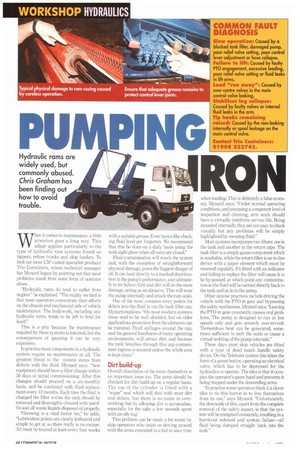Hydraulic rams are widely used, but commonly abused. Chris Graham has been finding out how to avoid trouble.
Page 46

If you've noticed an error in this article please click here to report it so we can fix it.
Wilen it comes to maintenance, a little attention goes a long way. This adage applies particularly to the type of hydraulic ram systems found on tippers, refuse trucks and skip loaders. To find out more CM visited specialist producer Trio Containers, where technical manager Ian Mynard began by pointing out that most problems result from some form of operator abuse.
"IIydraulic rams do tend to suffer from neglect." he explained. "The reality we find is that most operators concentrate their efforts on the chassis and mechanical side of vehicle maintenance. The bodywork, including any hydraulic rams, tends to be left to fend for itself."
This is a pity because the maintenance required by these systems is minimal, but the consequences of ignoring it can be very expensive..
In practice most components in a hydraulic system require no maintenance at all. The greatest threat to the system stems from defects with the fluid. Mynard says: "New equipment should have a filter change within 30 days of initial commissioning. After this changes should proceed on a six-monthly basis, and be combined with fluid replacement every 12 months. Each time the fluid is changed the filter within the tank should be removed and thoroughly cleaned with paraffin and all waste liquids disposed of properly.
"Greasing is a vital factor too," he adds. "Lubrication points are clearly indicated and simple to get at so there really is no excuse. All must he treated at least every four weeks
111 it gl-t'aSt*, EVVII XISIC:-; like check
ing fluid level get forgotten. We recommend that this be done on a daily basis using the tank sight glass when all rams are closed."
Fluid contamination will wreck the system and, with the exception of straightforward physical damage, poses the biggest danger of all. It can lead directly to a marked deterioration in the pump's performance. and ultimately to its failure. Grit and dirt will do the most damage, acting as an abrasive. This will wear the pump internally and attack the ram seals.
One of the most common entry points for debris into the fluid is via the tank filler cap. Mynard explains: "On most modern systems these tend to be well shielded, but on older applications protection from the elements can be minimal. Fluid spillages around the cap, and the general harshness of many operating environments, will attract dirt, and because the tank breathes through this cap contaminant ingress is assured unless the whole area is kept clean."
Dirt build-up
Overall cleanliness of the rams themselves is an important issue too. The arms should be checked for dirt build-up on a regular basis. The top of the cylinder is fitted with a "wiper" seal which will deal with most dirt and debris, but there is no point in overworking this by allowing dirt to accumulate, especially for the sake a few seconds spent with an oily rag.
This problem can be made a lot worse by skip operators who insist on driving around with the arms extended in a bid to save rime when loading. This is definitely a false economy. Mynard says: "Under normal operating conditions, and assuming a competent level of inspection and cleaning, arm seals should have a virtually indefinite service life. Being mounted internally they are not easy to check visually but any problems will be simply highlighted by weeping fluid."
Most systems incorporate two filters: one in the tank and another in the return pipe. The tank filter is a simple gauze component which is washable, while the return filter is an in-line device with a paper element which must be renewed regularly. It's fitted with an indicator and failing to replace the filter will cause it to be by-passed, at which point any contamination in the fluid will be carried directly back to the tank and on in to the pump.
Other unwise practices include driving the vehicle with the PTO in gear and bypassing the safety mechanism. Mynard says: "Leaving the PTO in gear constantly causes real problems. The pump is designed to run at low speeds only and gets severely over-revved. Tremendous heat can be generated, some times sufficient to melt the seals or cause a virtual welding of the pump internals."
These days most skip vehicles are fitted with a type of dead man's handle safety device. On the Telehoist system this takes the form of a green button, operating an electrical valve, which has to be depressed for the hydraulics to operate. The idea is that it occupies the operator's spare hand and prevents it being trapped under the descending arms.
"In practice some operators think it a clever idea to tie this button in to free themselves from its use," says Mynard. "Unfortunately, the downside of this, apart from the complete removal of the safety aspect, is that the system will be energised constantly, resulting in a burnt-out solenoid and system failure—all fluid being dumped straight back into the tank."
COMMON FAULT DIAGNOSIS
Slow operation: Caused by a blocked tank filter, damaged pump, poor relief valve setting, poor control lever adjustment or hose collapse. Failure to lift: Caused by faulty PTO engagement, excessive loading, poor relief valve setting or fluid leaks in lift arms.
Load "run away": Caused by over-centre valves in the main control valve leaking, Stabiliser leg collapse: Caused by faulty valves or internal fluid leaks in the arm.
PING Tip hooks remaining raised: Caused by the ram leaking internally or spool leakage on the main control valve. Contact Trio Containers: 01908 222743_




























































































































